Extending AVHRR Climate Data Records into the VIIRS Era for Polar Climate Research
Highlights
- A statistical method for intercalibrating VIIRS bands to AVHRR channels allows for the use of previously developed AVHRR algorithms with VIIRS data.
- Two existing AVHRR climate data records are now being continued with VIIRS: the Polar Pathfinder Fundamental Climate Data Record (FCDR) and the Polar Pathfinder Extended Thematic Climate Data Record (TCDR). The TCDR provides high latitude surface properties, cloud characteristics, and the radiation budget.
- Combining AVHRR and VIIRS data into long-term, continuous, consistent, and traceable CDRs provides the fundamental tools for monitoring the polar environment, its weather, and climate.
- The use of the original AVHRR Polar Pathfinder CDRs has resulted in many discoveries about polar climate trends and interactions. Extending the time series with VIIRS will allow the scientific community to continue polar climate research with these products well into the future.
Abstract
1. Introduction
2. VIIRS Global Area Coverage
3. Intercalibration
4. Validation
4.1. VPP vs. APP
4.2. VPP-x vs. APP-x
5. Verification of Time Series
5.1. VPP and APP
5.2. VPP-x and APP-x
6. Summary and Conclusions
Author Contributions
Funding
Data Availability Statement
Acknowledgments
Conflicts of Interest
References
- Key, J.; Wang, X.; Liu, Y.; Dworak, R.; Letterly, A. The AVHRR Polar Pathfinder Climate Data Records. Remote Sens. 2016, 8, 167. [Google Scholar] [CrossRef]
- Karlsson, K.-G.; Håkansson, N.; Eliasson, S.; Wolters, E.; Scheirer, R. Extension of AVHRR-based climate data records: Exploring ways to simulate AVHRR radiances from Suomi-NPP VIIRS data. EGUsphere 2025, 18, 3833–3855. [Google Scholar] [CrossRef]
- Vermote, E.; Justice, C.; Csiszar, I.; Eidenshink, J.; Myneni, R.; Baret, F.; Masuoka, E.; Wolfe, R.; Claverie, M.; NOAA CDR Program. NOAA Climate Data Record (CDR) of AVHRR Surface Reflectance; Version 4; NOAA National Climatic Data Center: Asheville, NC, USA, 2014.
- Kilpatrick, K.; Williams, E.J.; Walsh, S.; Evans, R.; Szczodrak, M.D.; Izaguirre, M.A.; Minnett, P.J. Extending the Satellite Derived Climate DATA Record of Sea Surface Temperature with VIIRS. In Proceedings of the American Geophysical Union, Fall Meet, San Francisco, CA, USA, 15–19 December 2014; p. IN12A-05. [Google Scholar]
- Knapp, K.; Young, A.; Inamdar, A.; Hankins, W. ISCCP and VIIRS: Adapting New Instruments to Extend Historical Climate Data Records. In Proceedings of the 2019 AMS Joint Satellite Conference, Boston, MA, USA, 28 September–4 October 2019. [Google Scholar]
- Kidwell, K.B. NOAA KLM User’s Guide with NOAA-N, -P Supplement; February 2009 Revisions; NOAA/NESDIS: Washington, DC, USA, 2009.
- Cao, C.; Xiong, X.; Blonski, S.; Liu, Q.; Uprety, S.; Shao, X.; Bai, Y.; Weng, F. Suomi NPP VIIRS Sensor Data Record Verification, Validation and Long-Term Performance Monitoring. J. Geophys. Res.-Atmos. 2013, 118, 11664–11678. [Google Scholar] [CrossRef]
- Cao, C.; Deluccia, F.; Qiu, S.; NOAA JPSS Program Office. NOAA JPSS Visible Infrared Imaging Radiometer Suite (VIIRS) Sensor Data Record (SDR) from IDPS; NOAA National Centers for Environmental Information: Mississippi State, MS, USA, 2012. [CrossRef]
- Key, J.; Liu, Y.; Wang, X.; NOAA CDR Program. NOAA Climate Data Record (CDR) of AVHRR Polar Pathfinder (APP) Cryosphere; Version 2.0; NOAA National Centers for Environmental Information (NCEI): Mississippi State, MS, USA, 2019. [CrossRef]
- Lyapustin, A.I.; Wang, Y.; Choi, M.; Xiong, X.; Angal, A.; Wu, A.; Doelling, D.R.; Bhatt, R.; Go, S.; Korkin, S.; et al. Calibration of the SNPP and NOAA 20 VIIRS sensors for continuity of the MODIS climate data records. Remote Sens. Environ. 2023, 295, 113717. [Google Scholar] [CrossRef]
- Cao, C.; Weinreb, M.; Xu, H. Predicting Simultaneous Nadir Overpasses among Polar-Orbiting Meteorological Satellites for the Intersatellite Calibration of Radiometers. J. Atmos. Ocean. Technol. 2004, 21, 537–542. [Google Scholar] [CrossRef]
- Cao, C.; Xiong, X.; Wu, A.; Wu, X. Assessing the consistency of AVHRR and MODIS L1B reflectance for generating Fundamental Climate Data Records. J. Geophys. Res. 2008, 113, D09114. [Google Scholar] [CrossRef]
- Chander, G.; Hewison, T.J.; Fox, N.; Wu, X.; Xiong, X.; Blackwell, W.J. Overview of Intercalibration of Satellite Instruments. In IEEE Transactions on Geoscience and Remote Sensing; IEEE: Hoboken, NJ, USA, 2013; Volume 51, pp. 1056–1080. [Google Scholar] [CrossRef]
- Wang, L.; Hu, X.; Chen, L.; He, L. Consistent Calibration of VIRR Reflective Solar Channels Onboard FY-3A, FY-3B, and FY-3C Using a Multisite Calibration Method. Remote Sens. 2018, 10, 1336. [Google Scholar] [CrossRef]
- Key, J.; Wang, X.; Liu, Y.; NOAA CDR Program. NOAA Climate Data Record of AVHRR Polar Pathfinder Extended (APP-X); Version 2; NOAA National Centers for Environmental Information: Mississippi State, MS, USA, 2019. [CrossRef]
- Wang, X.; Key, J. Arctic Surface, Cloud, and Radiation Properties Based on the AVHRR Polar Pathfinder Data Set. Part I: Spatial and Temporal Characteristics. J. Clim. 2005, 18, 2558–2574. [Google Scholar] [CrossRef]
- Wang, X.; Key, J.; Kwok, R.; Zhang, J. Comparison of sea ice thickness from satellites, aircraft, and PIOMAS data. Remote Sens. 2016, 8, 713. [Google Scholar] [CrossRef]
- Liu, Y.; Ackerman, S.; Maddux, B.; Key, J.; Frey, R. Errors in cloud detection over the Arctic using a satellite imager and implications for observing feedback mechanisms. J. Clim. 2010, 23, 1894–1907. [Google Scholar] [CrossRef]
- Liu, Y.; Key, J.; Wang, X. Influence of changes in sea ice concentration and cloud cover on recent Arctic surface temperature trends. Geophys. Res. Lett. 2009, 36, L20710. [Google Scholar] [CrossRef]
- Wang, X.; Liu, Y.; Key, J.; Dworak, R. A New Perspective on Four Decades of Changes in Arctic Sea Ice from Satellite Observations. Remote Sens. 2022, 14, 1846. [Google Scholar] [CrossRef]
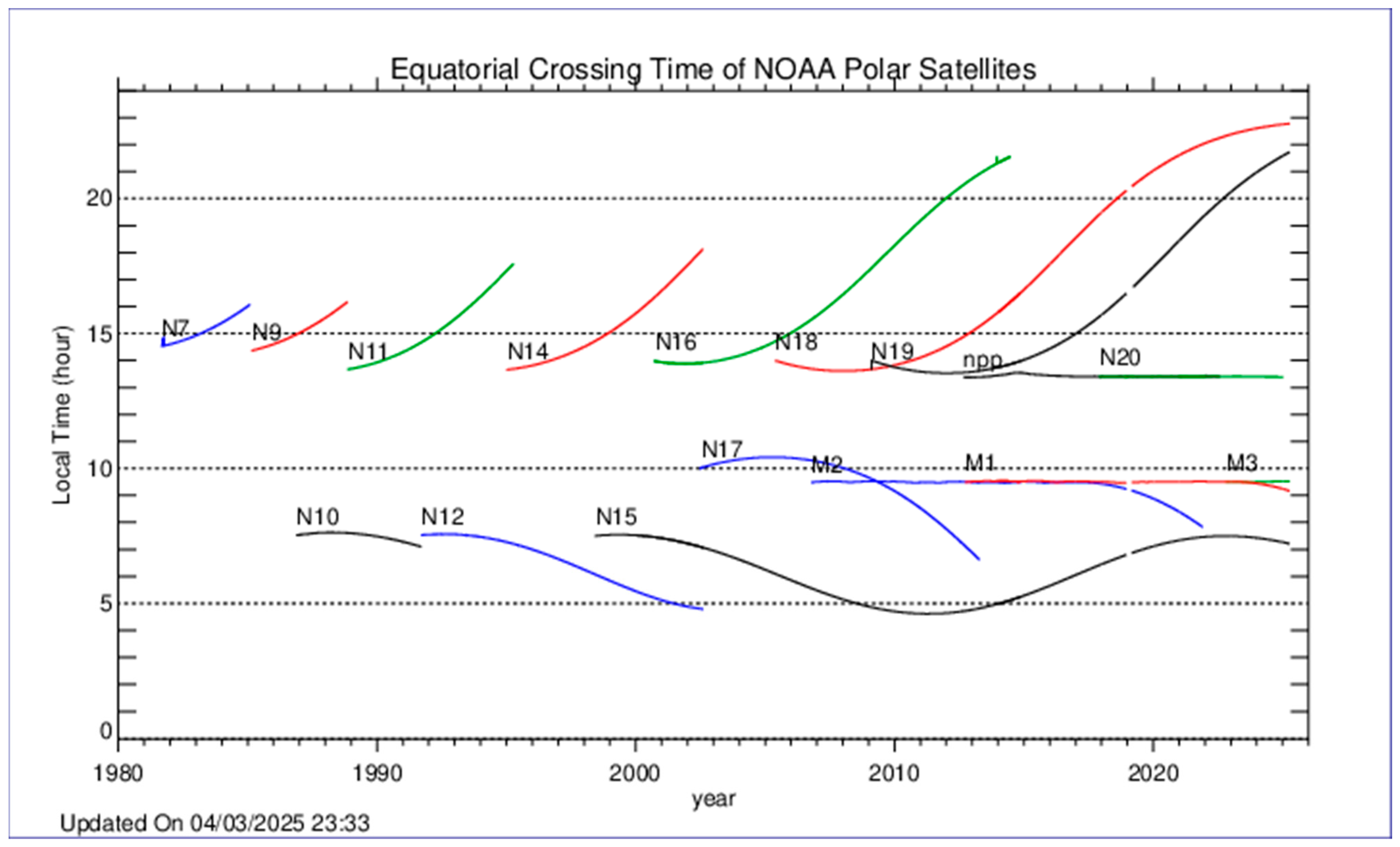

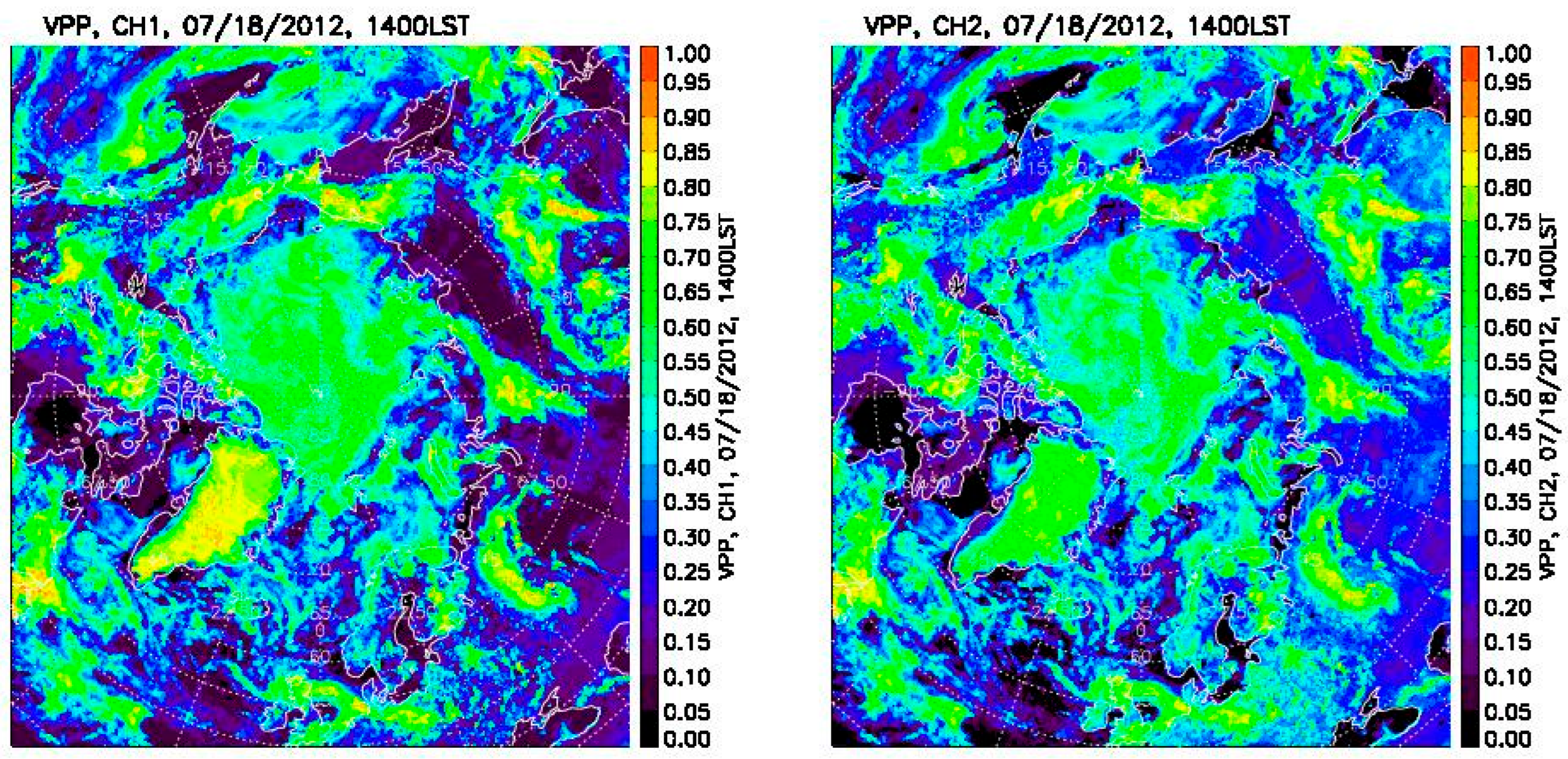
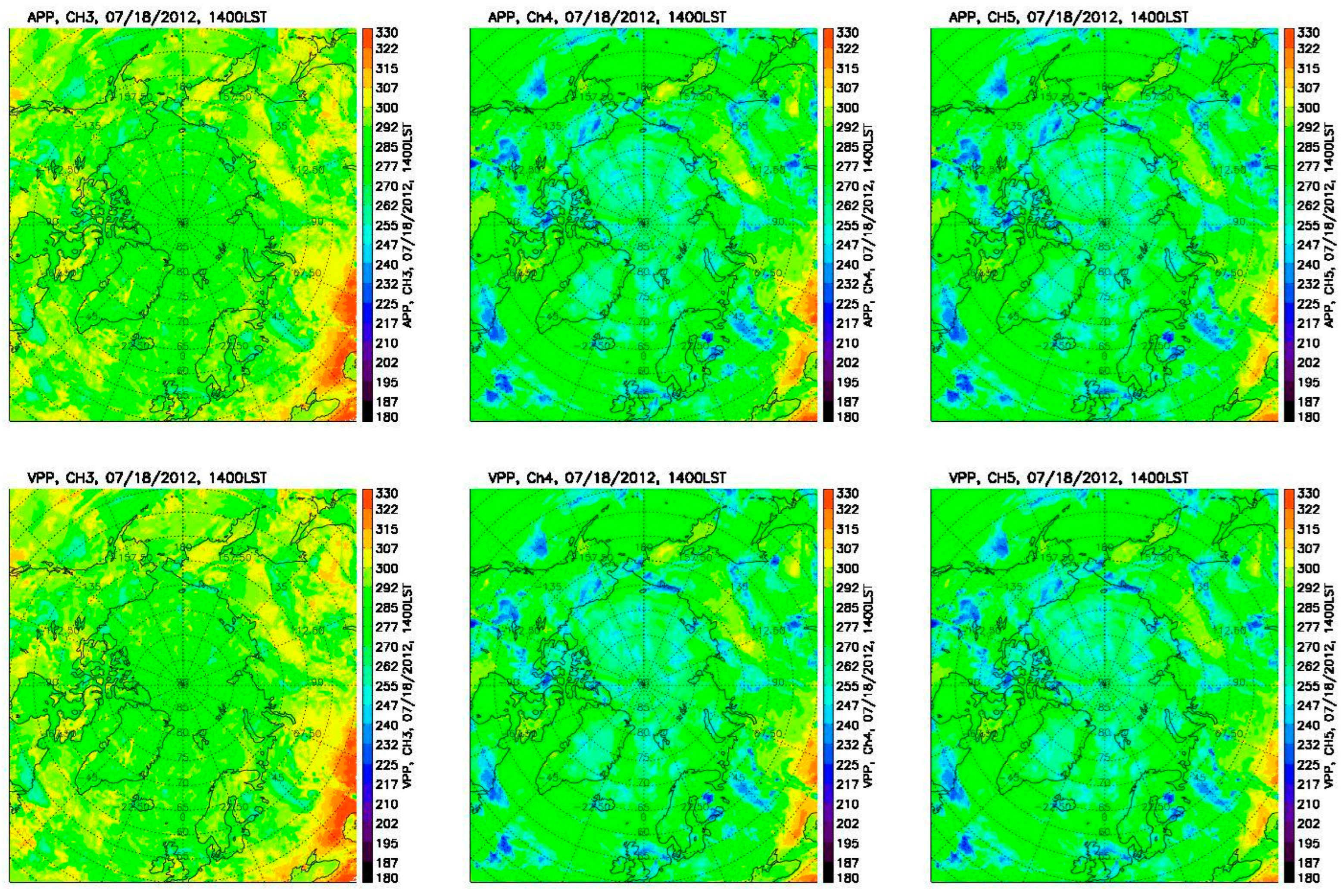

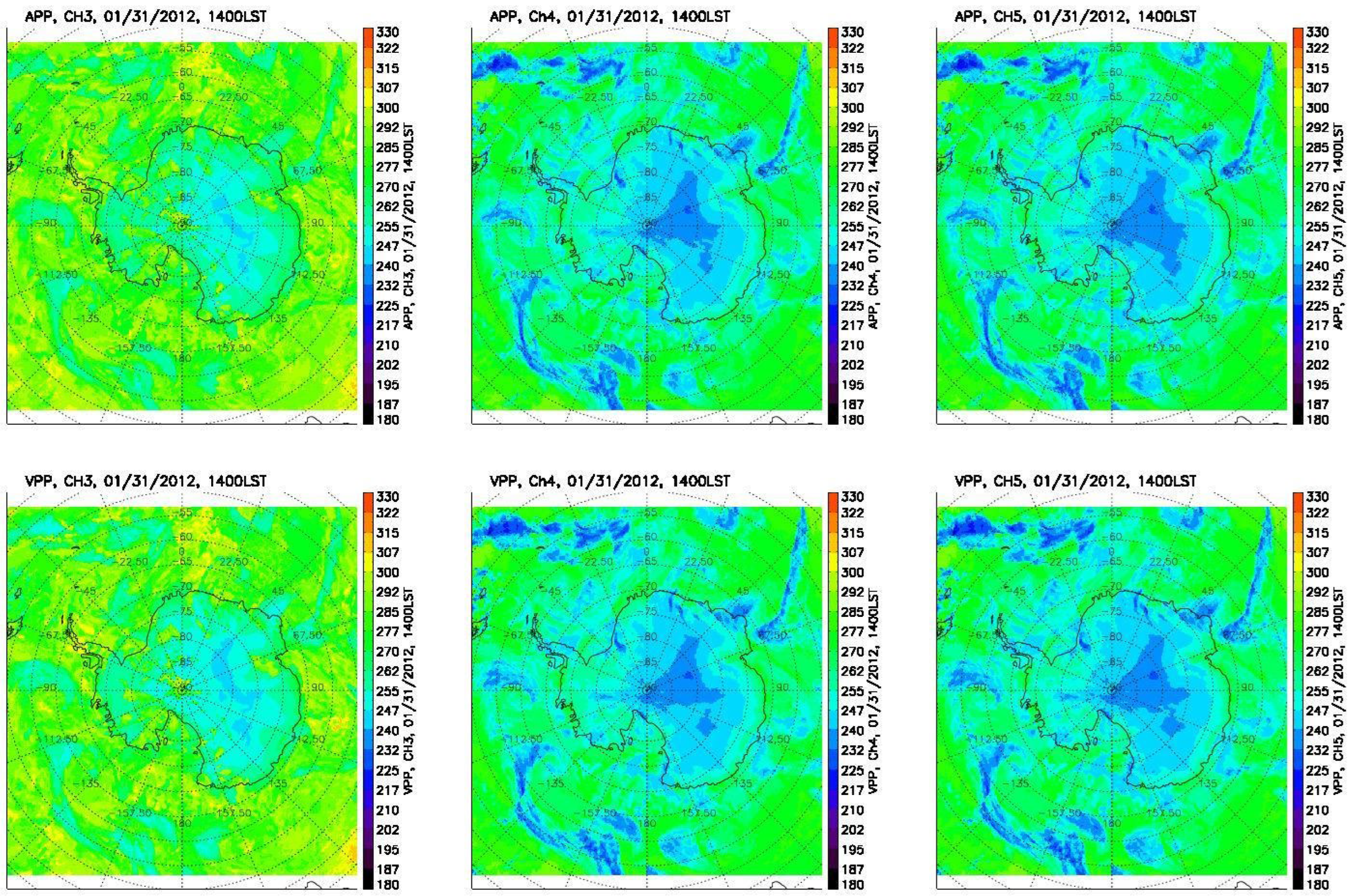


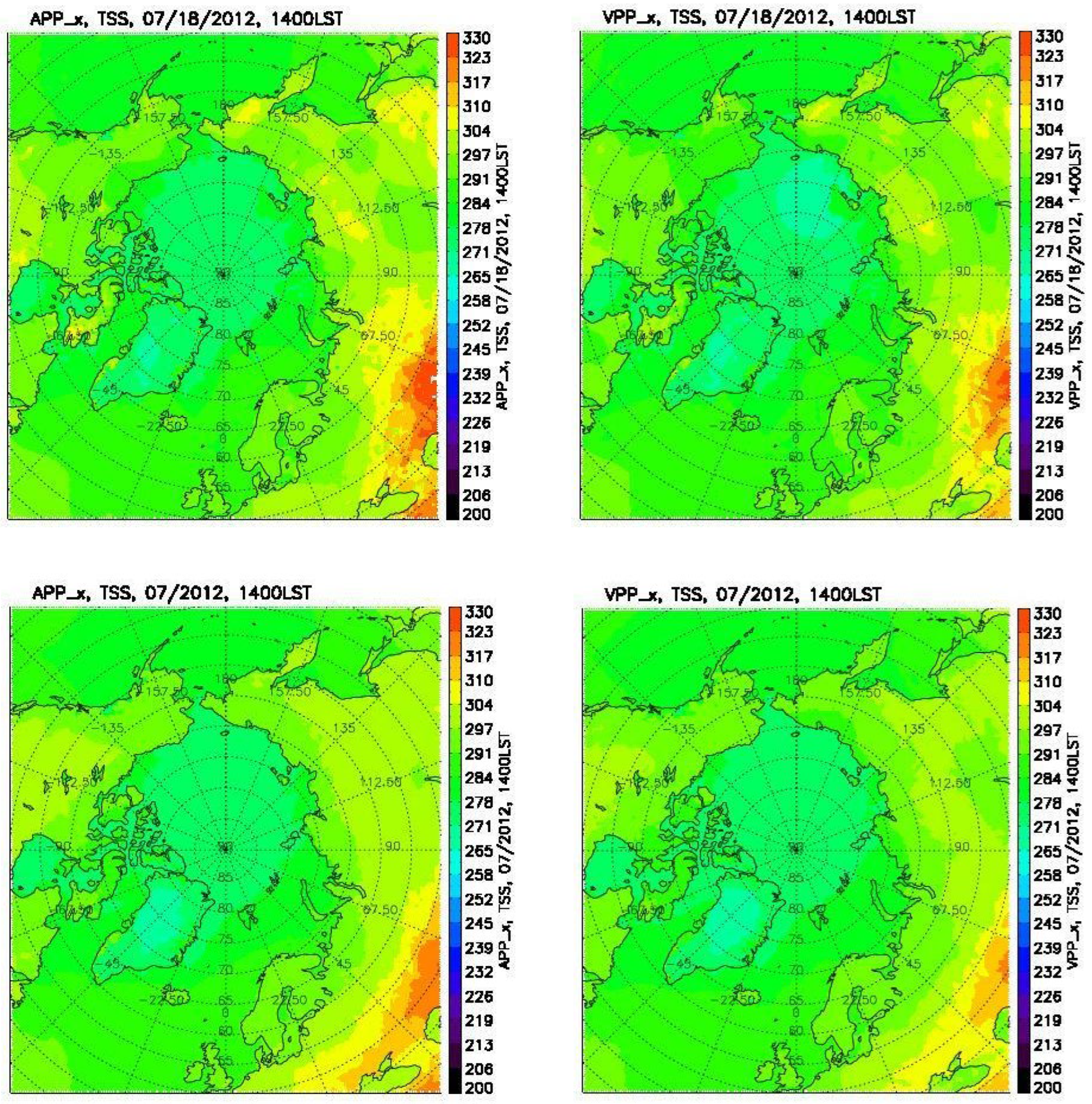
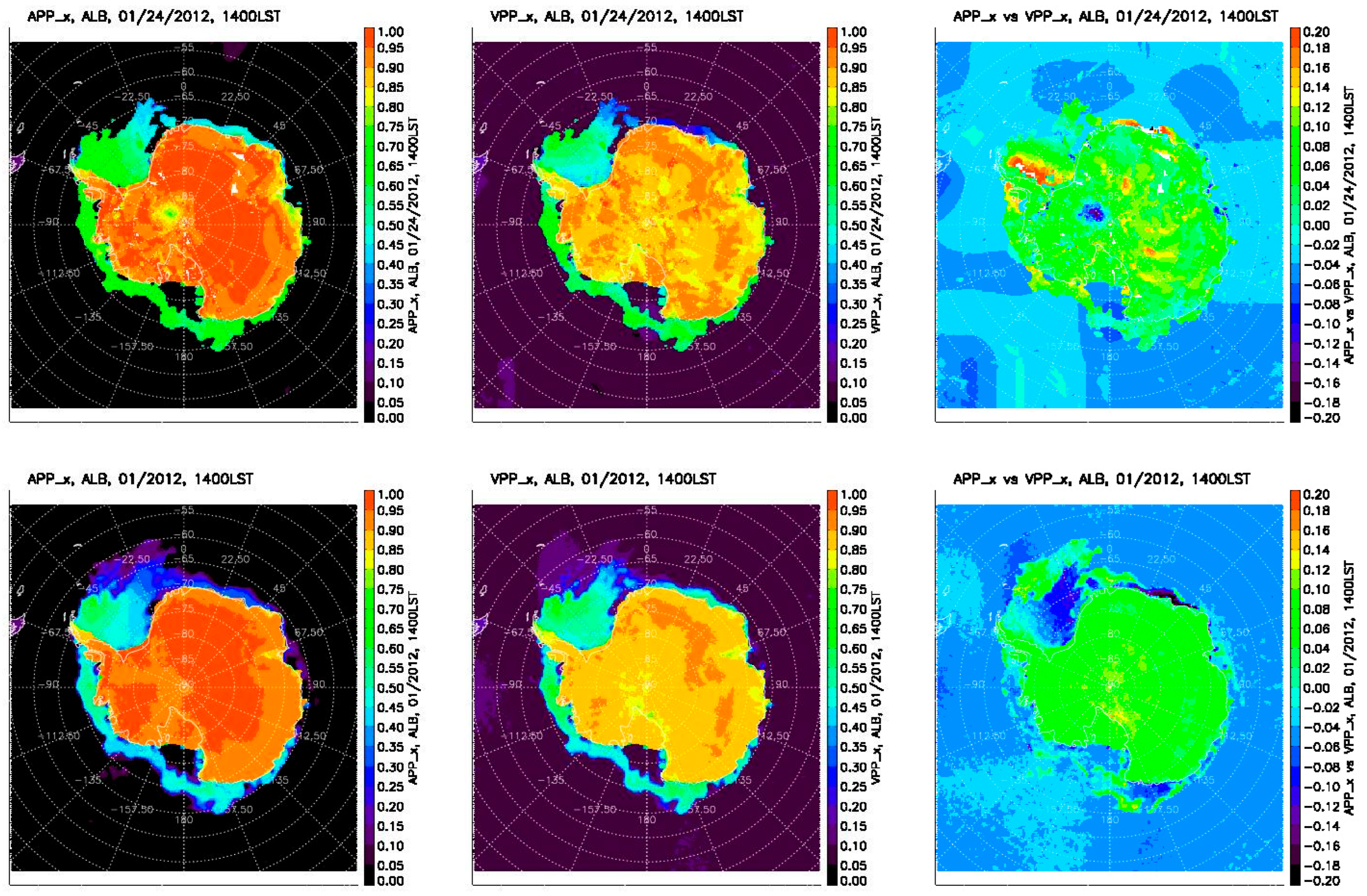
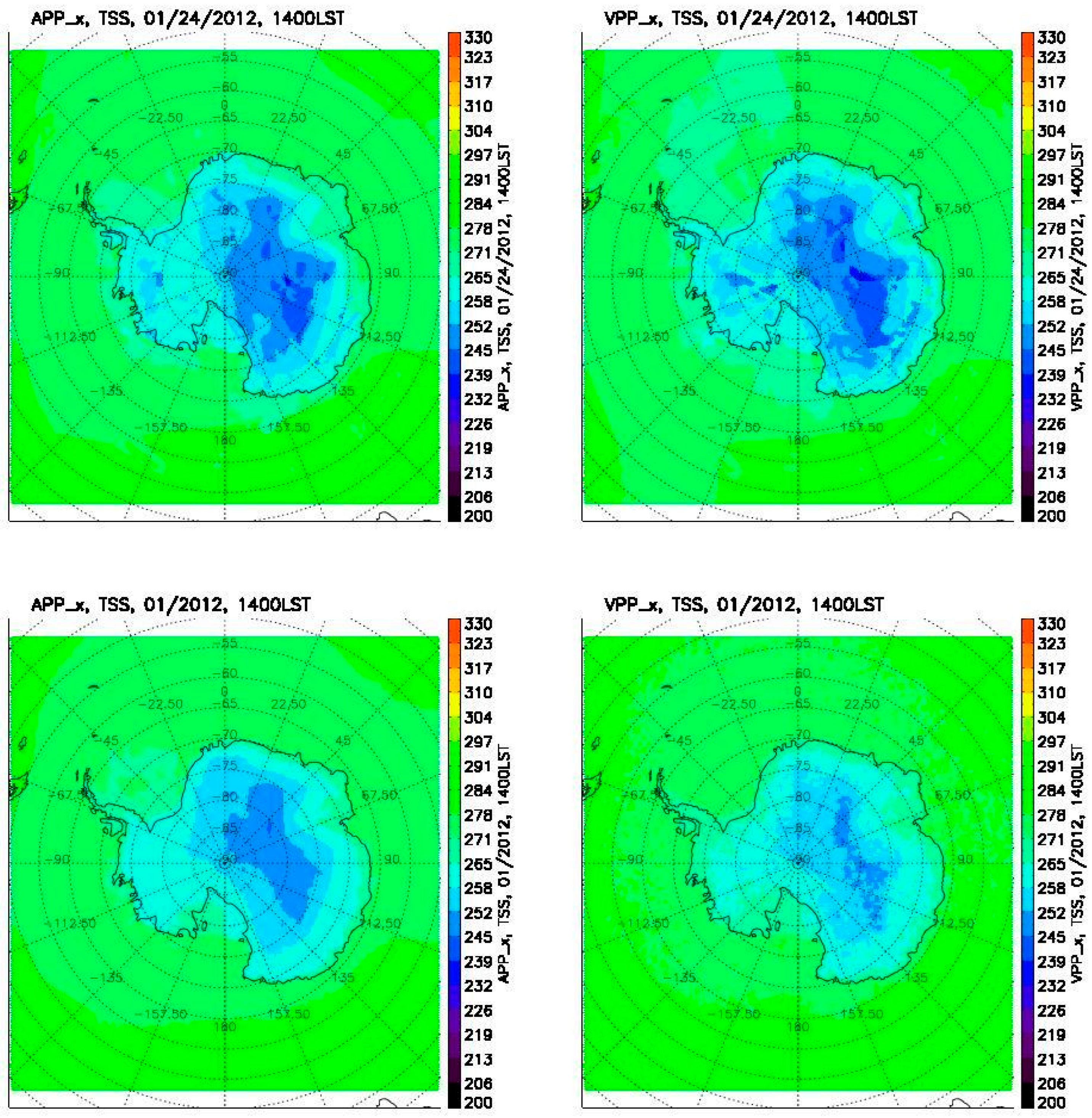
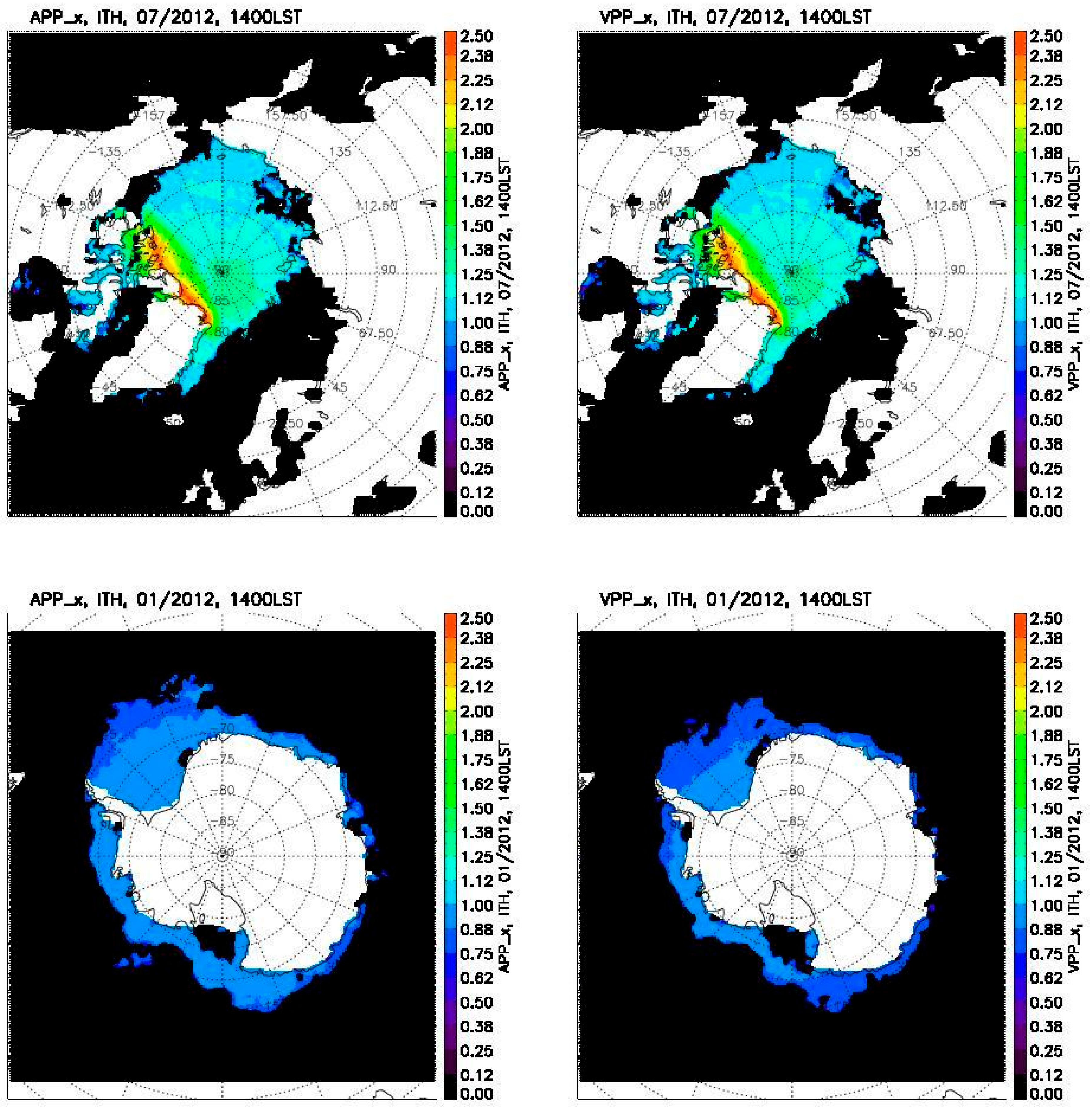
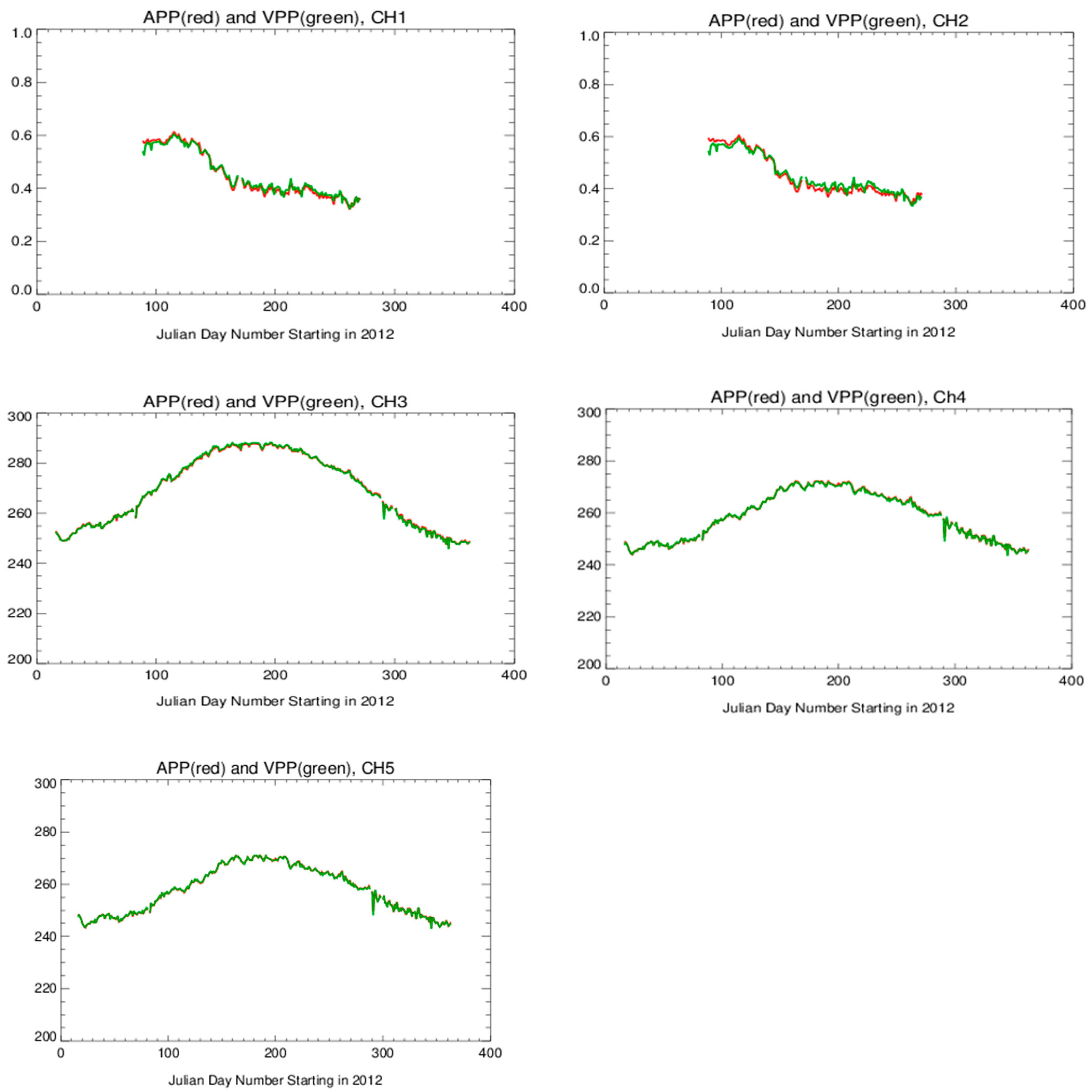
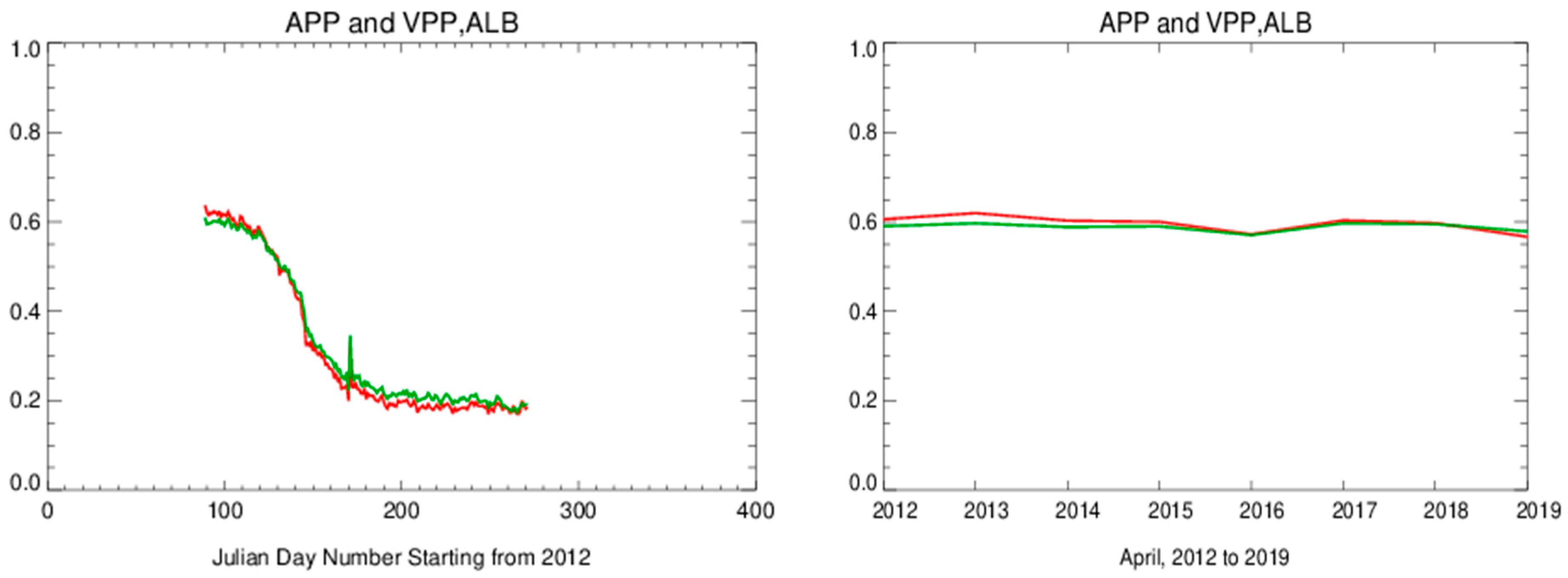
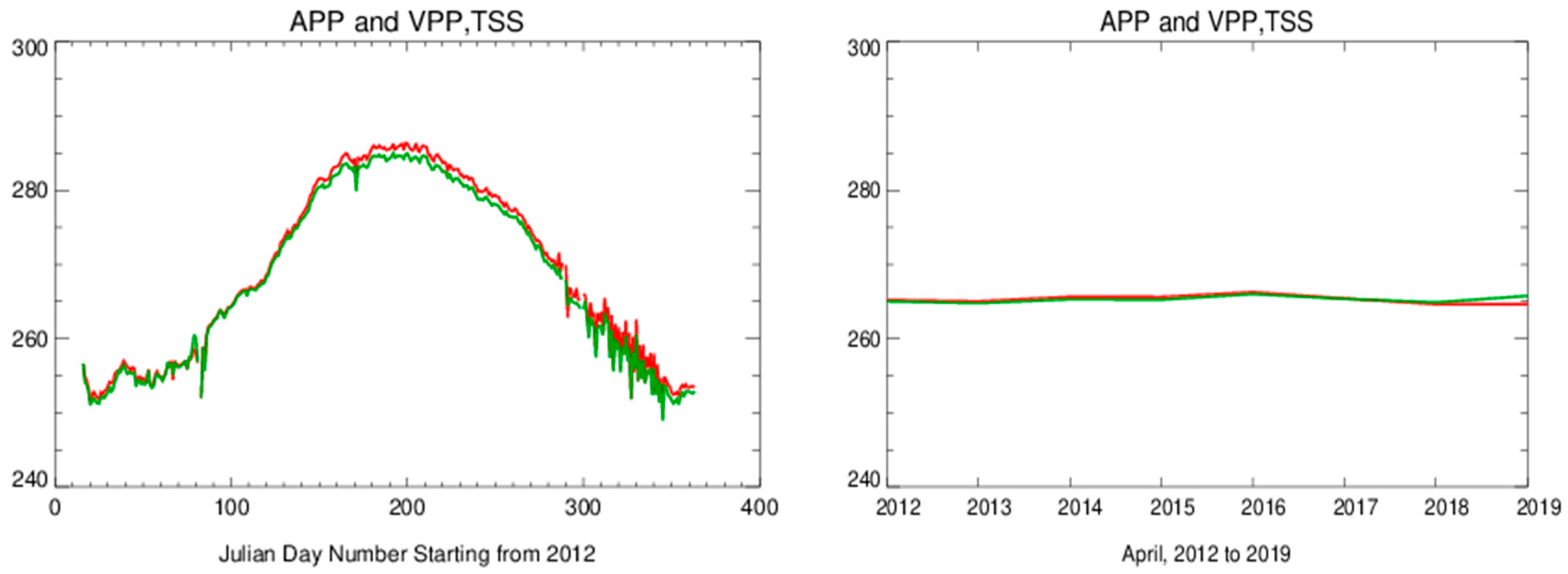
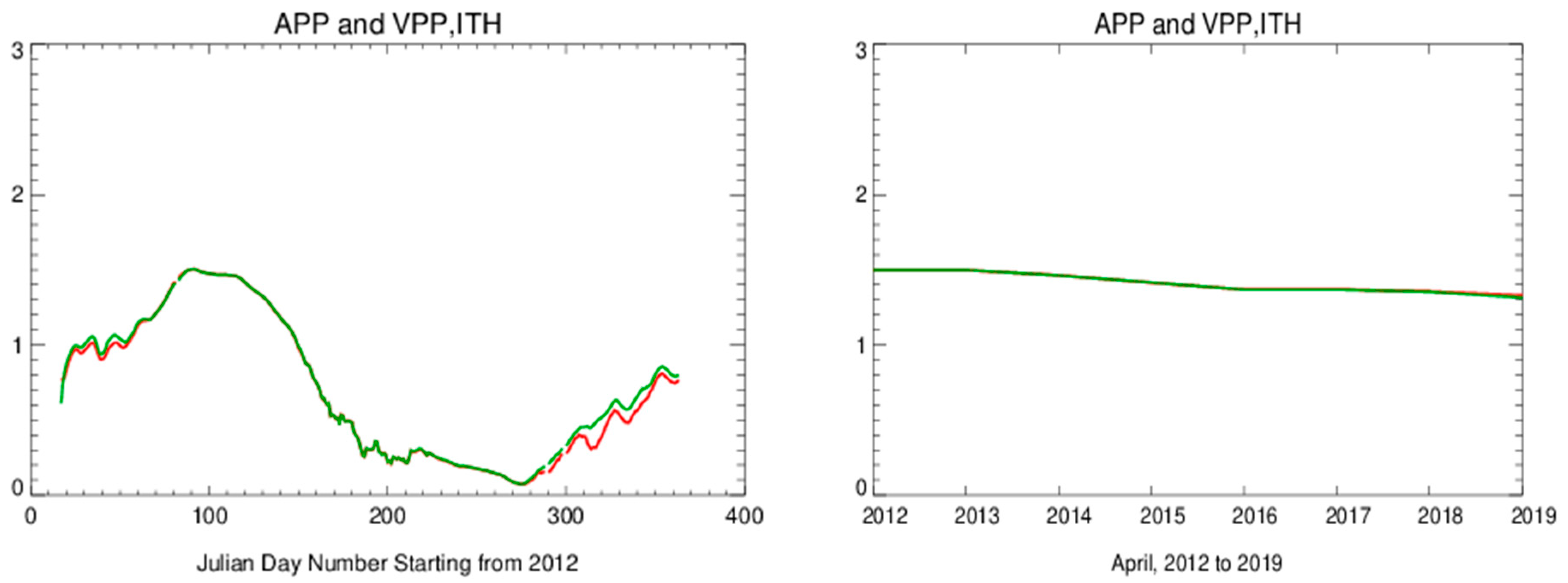
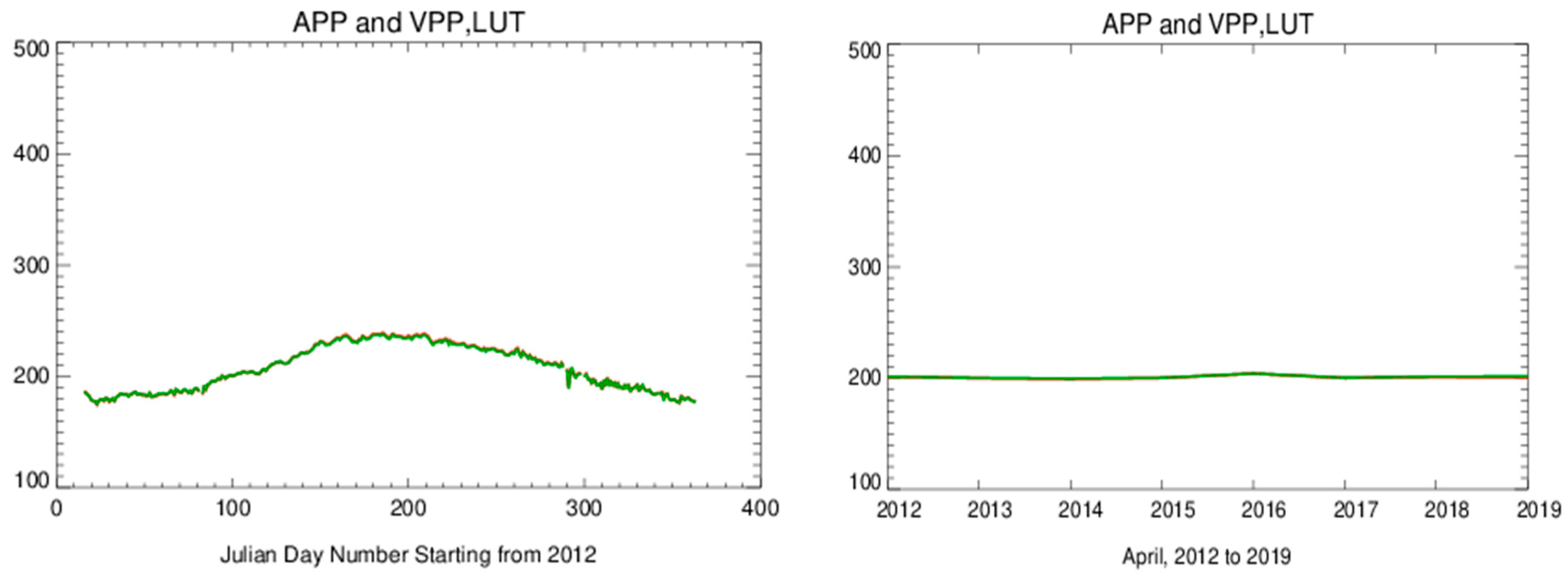
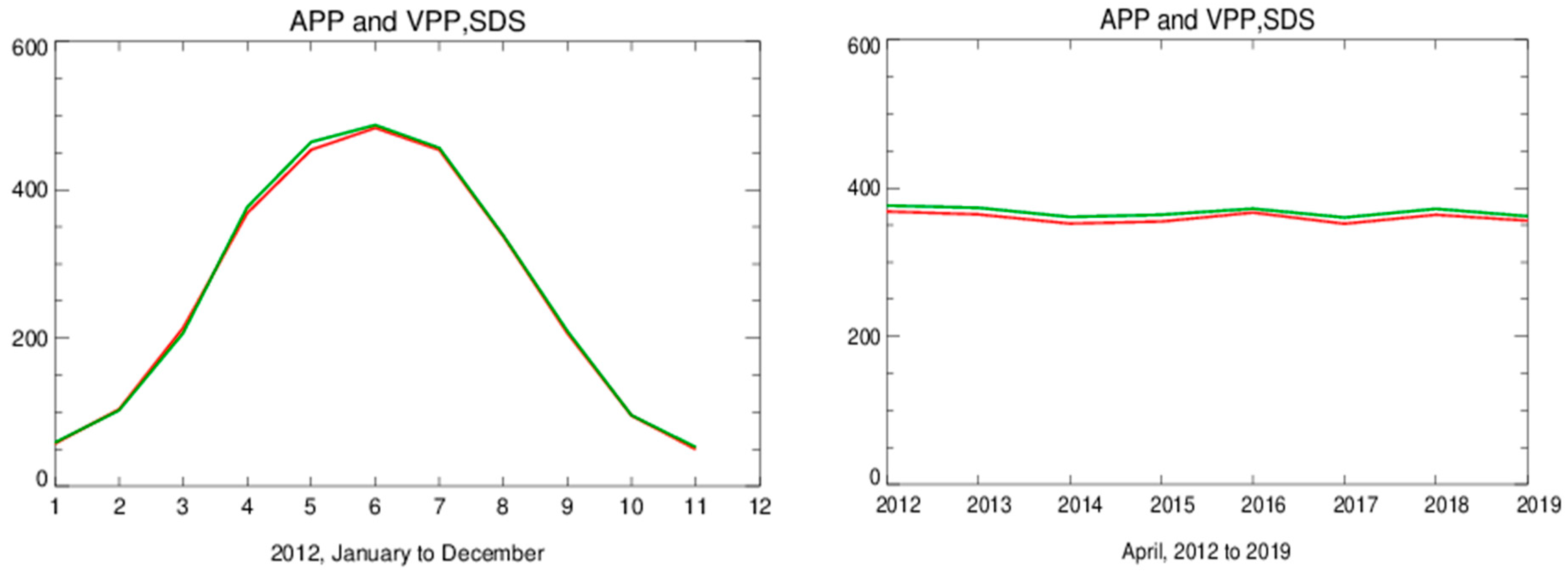
| AVHRR/VIIRS | TIROS-N | NOAA-6, 8, 10 | NOAA-7, 9, 11, 12, 14 | NOAA-15 and Onward | Suomi NPP, NOAA-20, NOAA-21 | GAC/VGAC Nadir Resolution (km) |
|---|---|---|---|---|---|---|
| AVHRR/1 | AVHRR/1 | AVHRR/2 | AVHRR/3 | VIIRS | 4.0 | |
| 1/I1 | 0.55–0.90 μm | 0.58–0.68 μm | 0.58–0.68 μm | 0.58–0.68 μm | 0.60–0.68 μm | 4.0 |
| 2/I2 | 0.725–1.10 μm | 0.725–1.10 μm | 0.725–1.10 μm | 0.725–1.00 μm | 0.85–0.88 μm | 4.0 |
| 3a/M10 | 1.58–1.64 μm | 1.58–1.64 μm | 4.0 | |||
| 3b/M12 | 3.55–3.93 μm | 3.55–3.93 μm | 3.55–3.93 μm | 3.55–3.93 μm | 3.61–3.79 μm | 4.0 |
| 4/M15 | 10.50–11.50 μm | 10.50–11.50 μm | 10.30–11.30 μm | 10.30–11.30 μm | 10.26–11.26 μm | 4.0 |
| 5/M16 | Ch4 repeated | Ch4 repeated | 11.50–12.50 μm | 11.50–12.50 μm | 11.06–12.96 μm | 4.0 |
| Channel | Arctic | Antarctica | ||||
|---|---|---|---|---|---|---|
| AVHRR | VIIRS | Coefficient | Local Solar Time (LST) | Local Solar Time (LST) | ||
| 14:00 | 04:00 | 14:00 | 02:00 | |||
| Channel 1 (unitless) | I 1 | a0 | 0.0444798 | 0.141376 | 0.0832267 | 0.333388 |
| a1 | 0.950818 | 0.833580 | 0.866825 | 0.625409 | ||
| a2 | 16.18118 × 10−5 | −0.000154396 | 9.89594 × 10−5 | −6.33436 × 10−6 | ||
| a3 | −0.000511533 | −0.00168859 | −0.00102623 | −0.00380498 | ||
| a4 | −0.000115240 | 0.000135720 | −5.24421 × 10−5 | 3.31371 × 10−6 | ||
| Correlation Coefficient | 0.9830 | 0.9791 | 0.9853 | 0.9596 | ||
| Channel 2 (unit-less) | I 2 | a0 | 0.0349208 | 0.0852699 | 0.0696203 | 0.275838 |
| a1 | 0.898762 | 0.848746 | 0.848746 | 0.617322 | ||
| a2 | −0.000150966 | −8.79787 × 10−5 | −0.000212826 | −5.60397 × 10−5 | ||
| a3 | −0.000271385 | −0.00104449 | −0.000755311 | −0.00308326 | ||
| a4 | −0.000170980 | 0.000180242 | −0.000120386 | 3.52749 × 10−6 | ||
| Correlation Coefficient | 0.9784 | 0.9678 | 0.9804 | 0.9138 | ||
| Channel 3b (K) | M 12 | a0 | 0.771362 | −4.27588 | − 24.5507 | −10.2141 |
| a1 | 1.00470 | 1.01925 | 1.07863 | 1.03415 | ||
| a2 | 0.00633876 | −0.0268919 | −0.0637815 | 0.0232074 | ||
| a3 | −0.0296343 | −0.0210368 | 0.0507004 | 0.00150771 | ||
| a4 | −0.00668837 | 0.0156104 | −0.0133655 | 0.00209493 | ||
| Correlation Coefficient | 0.9912 | 0.9868 | 0.9932 | 0.9794 | ||
| Channel 4 (K) | M 15 | a0 | 7.68617 | 4.65945 | −1.68492 | 2.17236 |
| a1 | 0.974410 | 0.986769 | 1.00598 | 0.988380 | ||
| a2 | 0 0.00610216 | −0.00839578 | −0.00626853 | 0.0185437 | ||
| a3 | −0.0137250 | −0.00633199 | 0.0104164 | 0.00225882 | ||
| a4 | −0.00101397 | −0.0102910 | −0.00913921 | 0.00304020 | ||
| Correlation Coefficient | 0.9865 | 0.9847 | 0.9962 | 0.9861 | ||
| Channel 5 (K) | M 16 | a0 | 9.58537 | 4.96841 | −1.34604 | 2.97693 |
| a1 | 0.966409 | 0.983610 | 1.00460 | 0.984615 | ||
| a2 | 0.00531683 | −0.00977714 | −0.00387729 | 0.0175073 | ||
| a3 | −0.0150232 | −0.00520482 | 0.0106972 | 0.00188959 | ||
| a4 | −0.000868135 | −0.00686013 | −0.0124573 | 0.00237256 | ||
| Correlation Coefficient | 0.9865 | 0.9842 | 0.9958 | 0.9864 | ||
| Pole | Arctic | Antarctic | ||||
|---|---|---|---|---|---|---|
| Year | 2012 | 2019 | 2012–2019 | 2012 | 2019 | 2012–2019 |
| LST | 14:00/04:00 | 14:00/04:00 | 14:00/04:00 | 14:00/02:00 | 14:00/02:00 | 14:00/02:00 |
| CH1 (%) | 0.18/0.42 | −2.85/6.72 | −0.85/3.03 | 2.69/−0.21 | −5.73/1.42 | 2.47/1.47 |
| STD | 1.05/1.17 | 0.97/4.76 | 1.25/1.53 | 1.00/2.71 | 3.57/2.77 | 1.31/1.25 |
| No. of cases | 181/182 | 180/014 | 1425/994 | 131/158 | 037/088 | 1133/1239 |
| CH2 (%) | 0.33/1.18 | −3.17/8.28 | −1.22/3.65 | 3.07/0.94 | −3.78/1.38 | 3.10/2.38 |
| STD | 1.44/1.63 | 1.14/1.78 | 1.48/1.58 | 0.99/3.13 | 5.02/2.79 | 1.02/1.56 |
| No. of cases | 181/182 | 180/035 | 1425/999 | 131/156 | 002/078 | 1121/1195 |
| CH3b (K) | −0.02/0.68 | −1.80/−0.91 | −0.18/0.81 | 0.16/−0.74 | −0.16/0.01 | 0.07/−0.68 |
| STD | 0.33/0.25 | 0.28/0.77 | 0.48/0.42 | 1.08/0.77 | 0.77/1.22 | 1.06/0.78 |
| No. of cases | 345/346 | 110/016 | 1996/1615 | 335/300 | 113/088 | 2165/2165 |
| CH4 (K) | 0.10/0.27 | −0.34/0.21 | −0.01/0.24 | 0.10/0.15 | −1.79/−0.40 | −0.32/−0.02 |
| STD | 0.24/0.16 | 0.26/0.67 | 0.25/0.34 | 0.19/0.14 | 0.23/0.27 | 0.60/0.27 |
| No. of cases | 346/346 | 364/365 | 2860/2861 | 347/345 | 216/364 | 2695/2861 |
| CH5 (K) | 0.01/0.23 | −0.39/0.14 | −0.07/0.20 | −0.07/0.09 | −1.94/−0.35 | −0.45/−0.04 |
| STD | 0.21/0.14 | 0.25/0.60 | 0.23/0.30 | 0.20/0.15 | 0.17/0.25 | 0.49/0.24 |
| No. of cases | 346/346 | 364/365 | 2860/2860 | 347/345 | 247/364 | 2575/2861 |
| Pole | Arctic | Antarctic | ||||
|---|---|---|---|---|---|---|
| Year | 2012 | 2019 | 2012–2019 | 2012 | 2019 | 2012–2019 |
| LST | 14:00/04:00 | 14:00/04:00 | 14:00/04:00 | 14:00/02:00 | 14:00/02:00 | 14:00/02:00 |
| ALB (%) | −0.99/−1.70 | −2.69/−1.89 | −1.52/−1.48 | 0.20/1.95 | −3.00/2.44 | 0.98/2.28 |
| STD | 1.44/2.14 | 0.93/2.08 | 1.45/2.26 | 1.87/2.07 | 0.11/1.61 | 1.98/1.80 |
| No. of cases | 183/167 | 183/168 | 1427/1305 | 164/109 | 170/126 | 1414/0999 |
| TSS (K) | 0.84/0.48 | 0.28/1.18 | 0.70/0.61 | 1.20/0.53 | 1.68/−0.61 | 1.39/0.04 |
| STD | 0.60/0.69 | 1.03/0.90 | 0.84/0.76 | 0.57/0.49 | 0.94/0.91 | 0.64/0.84 |
| No. of cases | 347/344 | 364/364 | 2852/2844 | 347/344 | 345/362 | 2830/2844 |
| ITH (m) | −0.02/−0.02 | −0.01/−0.03 | −0.01/−0.02 | −0.01/0.01 | −0.02/0.01 | −0.01/0.01 |
| STD | 0.03/0.03 | 0.02/0.03 | 0.02/0.02 | 0.02/0.02 | 0.03/0.03 | 0.03/0.03 |
| No. of cases | 347/344 | 364/364 | 2878/2879 | 347/344 | 345/362 | 2830/2844 |
| CMK (%) | 2.58/3.77 | 2.35/4.66 | 2.10/−2.02 | 3.87/4.32 | 2.38/2.15 | 4.79/2.70 |
| STD | 5.02/6.74 | 10.1/6.88 | 5.35/6.60 | 5.46/4.02 | 8.51/6.86 | 11.0/4.92 |
| No. of cases | 347/346 | 364/364 | 2852/2850 | 347/346 | 354/362 | 2843/2850 |
| SDS (W/m2) | −3.21/0.61 | −2.69/−7.10 | −3.16/−1.67 | −5.79/4.94 | −1.90/9.70 | −7.45/7.01 |
| STD | 4.20/3.08 | 7.90/5.44 | 5.83/5.09 | 6.77/7.98 | 14.87/7.46 | 6.62/6.85 |
| No. of cases | 301/159 | 265/156 | 2392/1231 | 221/104 | 005/101 | 993/917 |
| LDS (W/m2) | 4.29/−0.91 | 0.80/5.59 | 3.17/0.33 | 4.56/2.50 | 9.12/−1.91 | 6.31/0.73 |
| STD | 3.73/5.58 | 6.60/7.35 | 4.40/5.77 | 4.33/2.93 | 9.52/6.39 | 5.43/4.67 |
| No. of cases | 335/336 | 349/363 | 2823/2832 | 344/342 | 162/359 | 2587/2829 |
| SUS (W/m2) | −2.73/−2.95 | −9.98/−8.15 | −4.94/−4.07 | −1.35/7.63 | −9.83/8.31 | −4.78/9.44 |
| STD | 5.95/4.46 | 5.95/5.52 | 6.46/5.14 | 7.06/9.78 | 3.48/10.0 | 7.85/9.42 |
| No. of cases | 303/159 | 248/158 | 2368/1233 | 237/081 | 023/057 | 1198/645 |
| LUS (W/m2) | 4.48/2.08 | 1.59/5.45 | 3.54/2.41 | 4.20/1.32 | 9.44/−2.44 | 5.47/−0.01 |
| STD | 3.47/4.03 | 4.76/5.22 | 4.06/3.96 | 3.05/2.37 | 6.83/4.44 | 4.67/3.81 |
| No. of cases | 344/342 | 361/364 | 2845/2840 | 347/344 | 297/362 | 2767/2838 |
| SUT (W/m2) | −2.73/−3.61 | −5.50/0.39 | −1.23/−1.97 | 6.68/7.78 | 2.29/10.58 | 6.58/9.13 |
| STD | 6.37/3.74 | 8.39/3.94 | 7.44/4.67 | 5.04/5.80 | 10.8/6.43 | 7.10/6.22 |
| No. of cases | 303/160 | 248/159 | 2409/1238 | 285/108 | 033/124 | 1699/982 |
| LUT (W/m2) | 0.31/0.35 | −0.43/0.24 | 0.12/0.35 | 0.11/0.41 | −4.68/−0.31 | −1.29/0.23 |
| STD | 0.55/0.36 | 0.77/1.07 | 0.83/0.91 | 0.39/0.40 | 2.29/0.58 | 2.21/0.56 |
| No. of cases | 347/344 | 364/364 | 2851/2843 | 347/344 | 353/362 | 2840/2843 |
Disclaimer/Publisher’s Note: The statements, opinions and data contained in all publications are solely those of the individual author(s) and contributor(s) and not of MDPI and/or the editor(s). MDPI and/or the editor(s) disclaim responsibility for any injury to people or property resulting from any ideas, methods, instructions or products referred to in the content. |
© 2025 by the authors. Licensee MDPI, Basel, Switzerland. This article is an open access article distributed under the terms and conditions of the Creative Commons Attribution (CC BY) license (https://creativecommons.org/licenses/by/4.0/).
Share and Cite
Wang, X.; Key, J.R.; Moeller, S.; Dworak, R.J.; Shao, X.; Knapp, K.R. Extending AVHRR Climate Data Records into the VIIRS Era for Polar Climate Research. Remote Sens. 2025, 17, 3495. https://doi.org/10.3390/rs17203495
Wang X, Key JR, Moeller S, Dworak RJ, Shao X, Knapp KR. Extending AVHRR Climate Data Records into the VIIRS Era for Polar Climate Research. Remote Sensing. 2025; 17(20):3495. https://doi.org/10.3390/rs17203495
Chicago/Turabian StyleWang, Xuanji, Jeffrey R. Key, Szuchia Moeller, Richard J. Dworak, Xi Shao, and Kenneth R. Knapp. 2025. "Extending AVHRR Climate Data Records into the VIIRS Era for Polar Climate Research" Remote Sensing 17, no. 20: 3495. https://doi.org/10.3390/rs17203495
APA StyleWang, X., Key, J. R., Moeller, S., Dworak, R. J., Shao, X., & Knapp, K. R. (2025). Extending AVHRR Climate Data Records into the VIIRS Era for Polar Climate Research. Remote Sensing, 17(20), 3495. https://doi.org/10.3390/rs17203495






